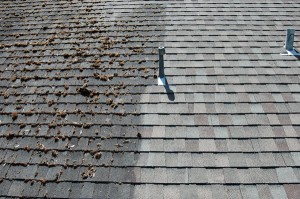Protect your investment with an essential cleaning service, or get the competitive edge in a buyers market.
competitive edge in a buyers market.
There is a war happening right now on your roof, and your roof is losing. Enemy camps of black algae known as Gloeocapsa magma have infiltrated. They are building in numbers and soon your roof will be over-run.
But all is not lost.
Know the enemy
Sun Tzu in the Art of War notes you will only be victorious if you know yourself and know your foe. At first glance, the black streaks on your roof appear to be nothing more than dirt, easy to wash off right? Infact, those black streaks are a living organism called Gloeocapsa magma and this airborne bacteria has found a great home on your roof. Todays fibreglass roofing shingles are manufactured with a limestone filler which holds moisture and organic material longer and is a great food source for bacteria.
There is some controversy whether this algae does damage itself, but it does affect the roof’s ability to reflect the sun’s rays which causes a heat buildup, not only causing an increase in cooling costs, but can also affecting the life expectancy of a shingled roof. Algae is also a precursor to moss growth which can damage roofing materials in a few ways. It holds water against your roof which can lead to rotting, and can expand and contract with freezing temperatures. Moss likes to grow near the edge of shingles which can lift up the shingles over time, and has root-like structures called rhizoids that can cause pitting of the shingles.
Choose your weapon
Now that you know what you’re up against you can more clearly plan your attack. But like any good battle commander knows, choosing the right weapon is key for success. An all-out frontal assault with a pressure washer is highly discouraged by both the Asphalt Roofing Manufacturers Association (ARMA) and The National Roofing Contractors Association ( NRCA) as you’ll likely remove a high degree of the granule surfacing that protects the roof from ultra-violet radiation.
Chemicals are the weapons of mass algae destruction and come in a variety of proprietary blends, but the same results can also be achieved by mixing some common household chemicals. Solutions range from one cup TSP, 4 litres of bleach and 20 litres of water, to one cup TSP, 10 litres of bleach, 10 litres of water. First, ensure all windows are closed and there are no cars in the driveway. Pre-rinse landscaping & plants, and periodically rinse during the cleaning process. Using normal safety precautions while handling bleach and using ladders disperse the solution onto the roofing surface using a garden sprayer. A soft bristle brush can be used to loosen large clumps of moss, but heavy brushing should be avoided. Allow the detergent to sit for five minutes and do not allow it to dry. Rinse and repeat as necessary.
Plan your defense
Moisture, cloud cover and shade promote rapid algae growth, and with 160 rainy days in Vancouver its easy to see that we have the perfect climate for algae. Reapplication can be required as early as six months after the initial treatment to maintain the appearance of the roof, or the installation of zinc strips along the roofline can provide ongoing defence against the growth of algae. Whether you choose to DIY or hire a professional, roof cleaning is a fraction of the replacement cost and essential to maximizing the lifespan of your roof.
– See more at: https://imagineservices.ca/blog/roof-cleaning#sthash.xOmUqtzT.dpuf